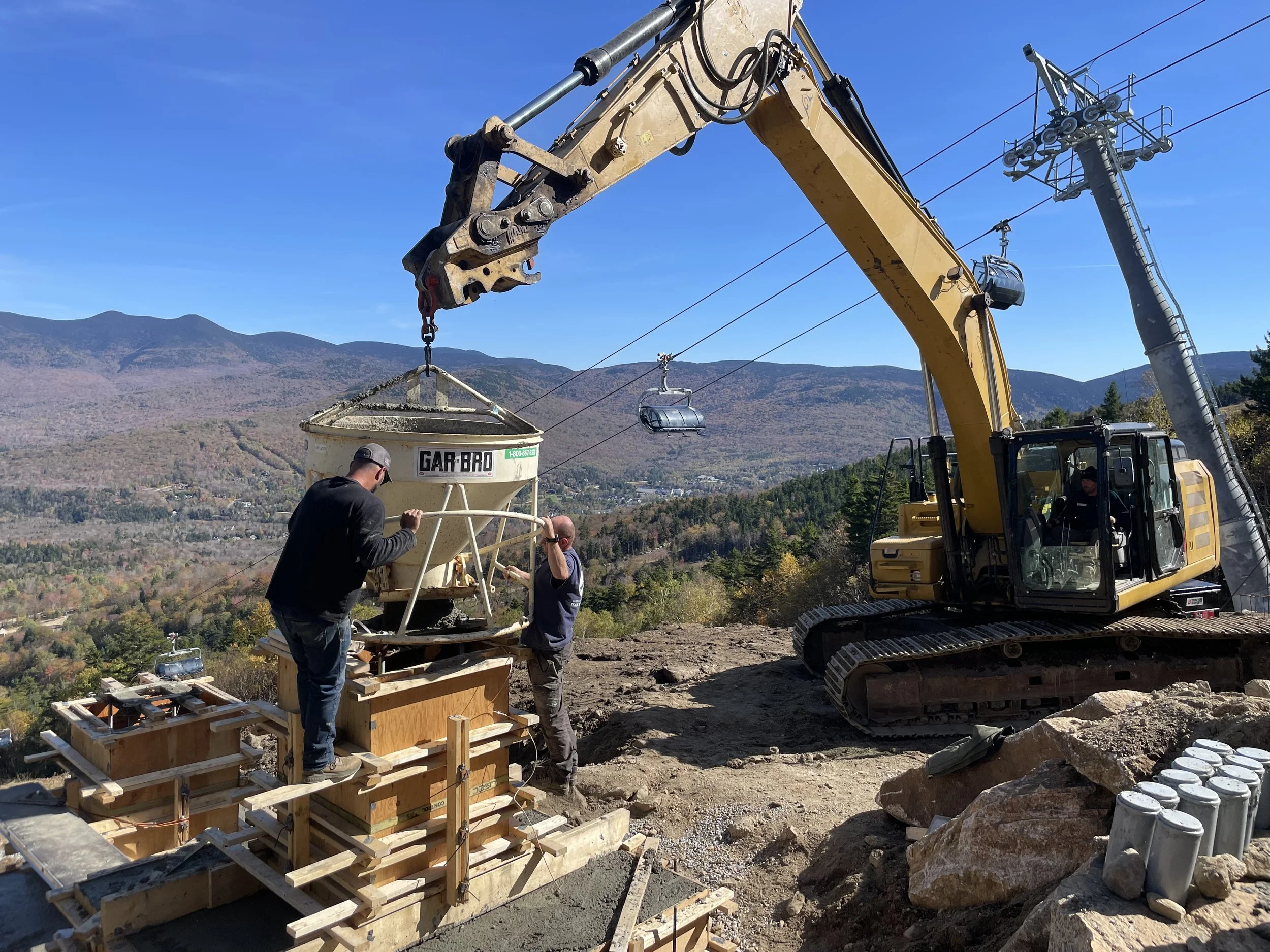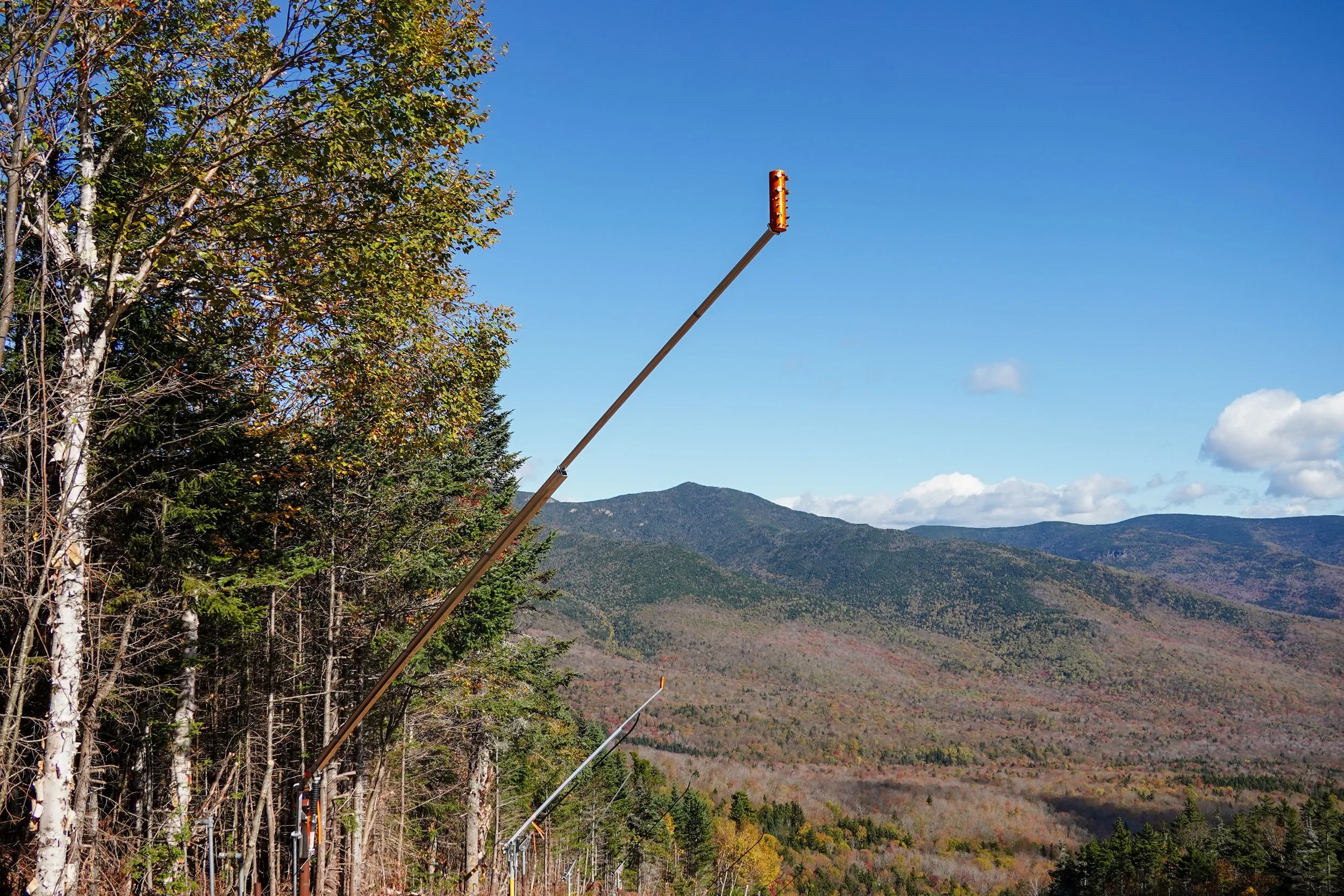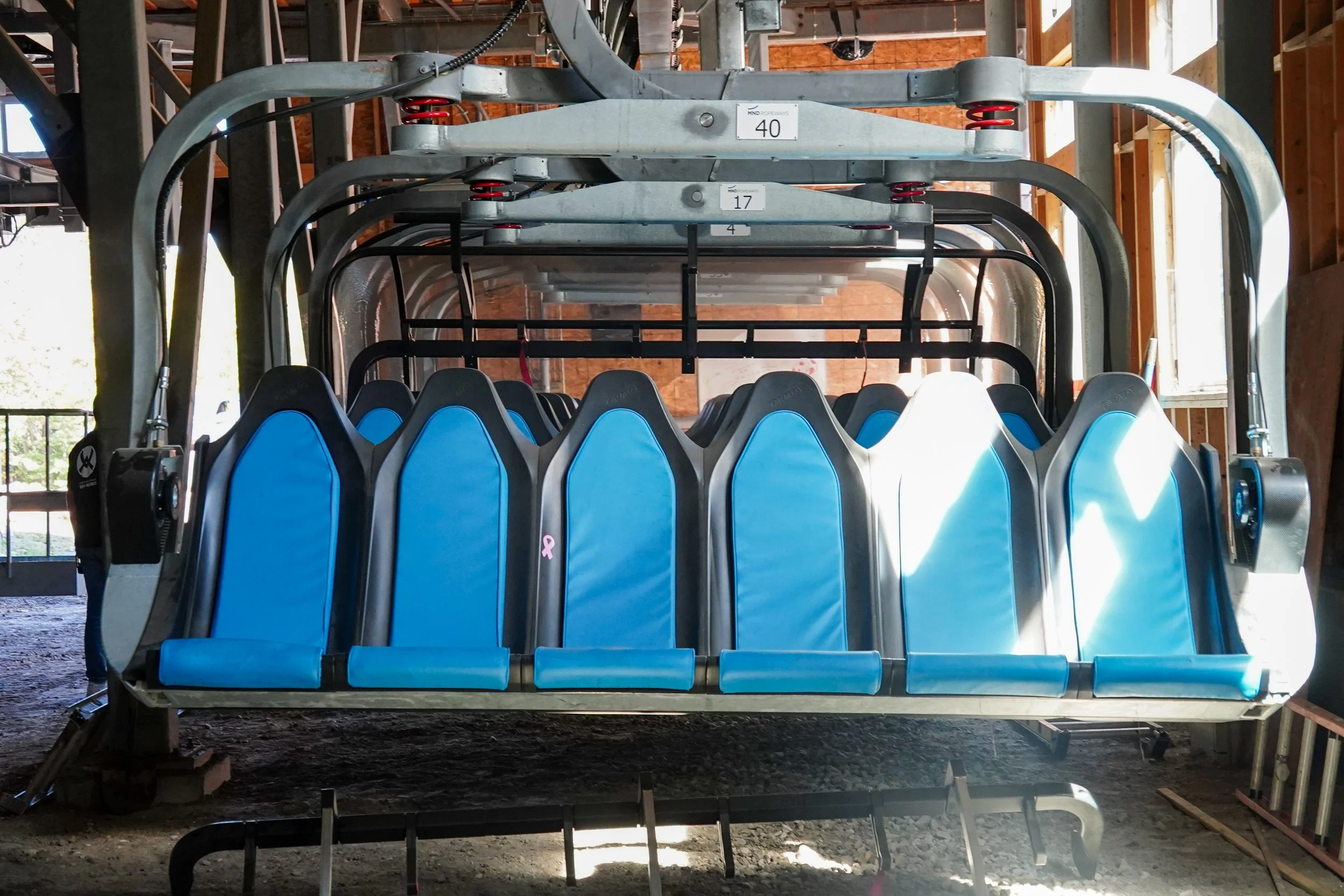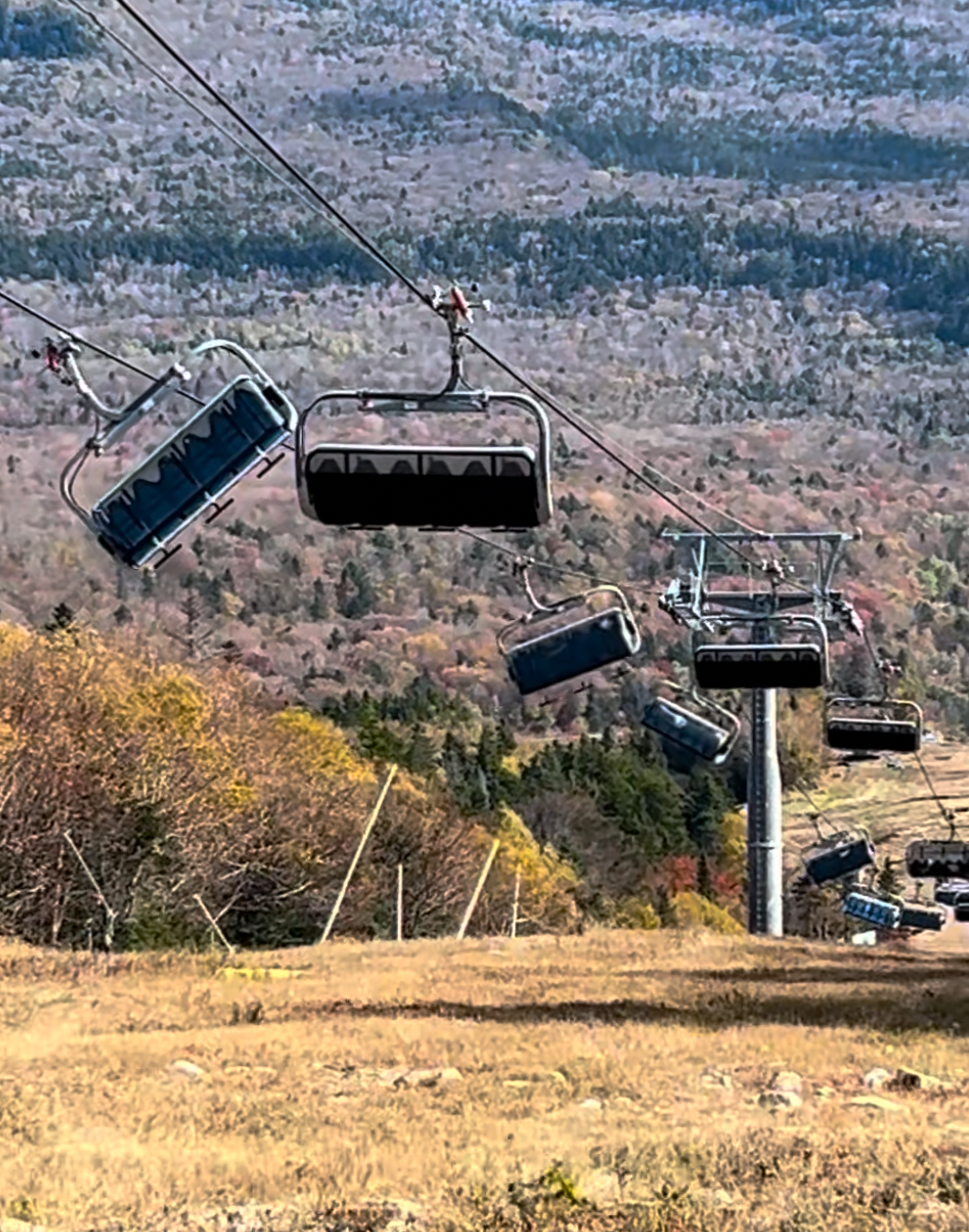Next Level Ops Report: Concrete, Threading the Needle, & THE Schwendi Fest Shift
Hi Friends,
I feel like it's been a decade since I last wrote to you. I think it's really only been a few weeks, maybe a month or two? I honestly don't know how long - Once the calendar hits August 1, it's like each day on the mountain snowballs into the next (and considerably faster each day) and the voice in my head screams "Winter is Coming!" a little louder every hour that goes by. As we count down the days until opening, I just wanted to reach out - to give you a little look at the controlled chaos of Ops as we prepare for the winter season.
CONCRETE IS THE WORST, PART II
In my last Ops report, we had only poured towers 1 - 6. And in that Ops report, I declared concrete to be the worst thing known to man. Oh my friends, how TRULY easy we had it pouring Towers 1 - 6... As of this writing, we have poured all eleven tours on the new t-bar and the lower terminal pedestal. Only the return bullwheel left to pour... Can I count for you the ways that concrete is the worst?
Tower 9: The tower that broke me. Pouring Tower 9 was a test to see how closely we could get to the top of the t-bar with a concrete truck under its own steam. The first truck made it up with little issue, except a tight turn around so that it could pour straight into the foundation. It was all smiles at the tower as we poured the pad for the tower base. The trucks could only bring 5 yards of concrete up the road that high and I had two trucks that day, 10 yards total, for a foundation that needed 9.3 yards. And even though 2/3rd 's of a yard seems plenty of waste, it really is dependent on many factors and I knew it was going to be tight. The second truck came up the hill, but the road had deteriorated in that last 30 mins- dust, rocks, soft - too tough for the second truck to turn around. He had to pour without getting his truck level. The concrete came out so slowly you could have counted the granular in the mix. Three men stood on top of the form trying to shovel the concrete out of the shoot as quickly as possible, while the rest of the team vibrated and smoothed the rest. The driver added a little water to the mix, so that the concrete would flow faster - but that also meant that it's not as stiff, which is nerve wracking for a monolithic pour. Just as I was thinking it would all be fine, the back of the form blew out and we lost a ½ yard in the blink of an eye. The men at the base were shoveling concrete five feet up in the air to get it back into the column. I climbed up to the top of the column, so I could watch every precious drop stack up, praying it would get to the bottom of the template. If you don't get to the bottom of the template - you are done - ripping out that footing and pouring a new one. Why? Cold seams are not allowed in the column of a lift foundation. You can't just mix up a bag of quickcrete to fill it up to the top. The spirits of the mountain had our backs that day - we just made it with maybe 2 cups of concrete to spare. As we smoothed the top of the concrete, we were silent - it was a win, but boy it didn't feel like one.
How do you get concrete to the bottom of the Chute? This has been a much-discussed topic in the last two months. The top of the t-bar is directly across from Tower 6 of Tecumseh. To get concrete to that spot during the build of TEX, the contractor had to tow up a concrete truck with a skidder - which ended with some VERY angry truck drivers and a ban on towing concrete trucks up the mountain. If the truck can't make it of its own accord, it won't go there. For the new t-bar, we revamped the construction road. Wally made a super highway, reinforced with rock walls, rubber water bars for erosion, banked turns, wide corners. We thought the trucks would make it to the top, but they came up 300 feet short of the return bull wheel and tower 10 and 11. If the truck can't make it, how do you get concrete there? Well, a helicopter is the easiest option - but its costly and not always readily available in our area. You can pump the concrete, you can bucket the concrete - Hell I thought about trying to mix it on site by buying a mobile concrete trailer and using snowmaking water pumped up the hill. We thought of at least 23 ways to get concrete to the top without getting a truck there, but none of the options were easy. They required manpower, equipment, and time (which we don't have). In the end, no matter what the task, you have to utilize the best equipment in your arsenal, your most reliable machines. For us, that is the 330 excavator and the Morooka track truck. The Cat 330 excavator is a work horse that has done the brunt of the digging for this project and for Tecumseh. She's a good machine. The Morooka is a tracked dump truck, meant for hauling rocks wherever they need to go. It's been hard to find a hill that Morooka couldn't climb. She's a good machine too. At first, we thought a crane off the back of Morooka would be the best option. We would simply hook a concrete bucket, meant for pouring 1 - 2 yards of concrete, to the crane, drive it up the 300 feet, hook it to the 330 and viola, concrete debacle solved. Vehicle maintenance welded together a crane design that would fit in the back. We decided we needed to test it out before we got tens of thousands of dollars worth of concrete onsite, so we hooked a concrete waste block to the crane and attempted to go up the t-bar line. About halfway up, the chain gave way and we lost the block down Exhibition! Never a dull day at Waterville Valley, friends. We got a stronger chain and tried again. This time we made it to the top, but Morooka was doing a wheelie the whole way.
Poor Morooka - We blew out an oil seal with these shenanigans, so into the shop she went. With a nice spa treatment at the shop and a new seal, Morooka was back in the game. It dawned on us that the only way to use her to her full potential was to put the weight where she wanted it - in the bed. And now I know I am using words to paint a picture, but follow along, friends. The point of the crane was to allow the concrete bucket to stay level no matter what pitch the track truck was traveling. What happens when you put concrete in the back of a truck going up a 30 degree pitch? Well, it spills. Everywhere. So we tested out the options - With Ethan in the track truck, he tried backing up the mountain and leveling out the dump bed as the pitch changed. This worked ! Little sloppy, but it worked! With hours to spare to the scheduled pour of Tower 10 and 11, we made the plan. And I'll spare you the gory details, but the basic math is this: concrete truck drives to the top pad on the work road, Morooka parks below it, concrete fills two buckets ¾ full in the back of Morooka, Bacon drives Morooka up backwards up the work road leveling it out as it goes up, Wally hooks the buckets with the 330 one at a time, Rob releases the handle, the crew shovels, vibrates and smooths. Repeat 13 times and you have Towers 10 and 11!
I stayed in the bed of Marooka for all 13 trips, watching our precious concrete go up the road without a drop spilled, taking turns hooking it to the 330 with Jake, while Tecumseh spinned overhead - getting staff and supplies up for Schwendi Fest. I don't think I can convey the wonder it is to build a lift, to operate a mountain - to look out on the majesty of the White Mountains as you do all these things. Somethings there are not words for - you just have to be there.
THREADING THE NEEDLE
There are two things on the mountain that do not mix: Snowmaking and lifts. When snowmaking happens too close to the lifts, it's a recipe for disaster. Towers and terminals and chairs and comm lines covered in ice. If you don't catch it before you start spinning for daily clearances, sheaves go flat. Lift maintenance has to spend the morning banging the ice off chairs and towers just to get the lift ready for the public and sometimes we have to replace sheaves. Last season, our snowmakers were very diligent, and we had minimal issues with the lifts. They were conscious of the winds and the direction snowmaking was blowing when they were near the lifts. But even with the most cautious crews, we still had a few towers hit. A few flat sheaves.
The new t-bar will pose an even bigger challenge. With two lifts just 55 feet from each other in some spots, and one dependent on snowmaking to open, we will need to thread the needle to make snow in between Tecumseh and the t-bar.
Last season, we kept the chairs off Tecumseh when we were making snow under the line when we weren't in operating hours. But if we were spinning and making snow, that meant we had guests on the line getting splattered with snow - and no one likes that. This made for an interesting conundrum if we needed to go back to those trails to make more snow - a dance of taking chairs off Tex, re-hosing the guns on that line, charging the snowmaking pipes that lead there, firing when we didn't have guests to not impact the experience. It was a hard dance to do - so we didn't go back. We farmed snow when we needed to, closed trails if it got too thin. And no one likes that as well.
And now, in comes HKD... With the new pipeline along the t-bar line, down the Chute and on skiers left of Exhibition, it was the optimal time to try out HKD's Klik hydrants. With built-in hoses that you never have to move, and hydrants that can be fired in the blink of the eye (and shut down just as quickly), they seem like the optimal set up to make these trails come to life, and back to life if needed. HKD also designed an optimal gun layout with Phaser guns of very specific lengths on adjustable jacks to ensure that we can place the snow exactly where we want it - in between the two lifts and not on top of them. We are starting to install all of this now, so that we can make snow for the t-bar line as soon as it is commissioned.
Two things are needed to make the basic experience for all resort guests: Lifts and snow. While snowmaking and lifts rarely cohabitate peacefully, my hope is that this collaboration with HKD will prove otherwise - snow in the places it belongs, under the feet of the skiers, and not stuck to the lift towers. We'll keep you posted!
MND RETURNS
At the opening of this ski season, we will have 5 MND lifts, 5 Staedli lifts (Born of Bartholet, but minded by Doppelmeyer) and 1 Doppelmeyr. I am proud that we are the only mountain in the country that can boast nearly 50% MND lifts. Their employees are unmatched . Julien, who helped build Tecumseh, is back right now - helping us tune Tecumseh and build the T-bar. The rest of the MND crew will be over from France shortly. While I am proud that we are building the new t-bar in house, I am thrilled to have the support of MND to oversee the project. Nothing about building a lift is straight forward - from engineering, to manufacturing, to shipping, to tariffs and government shutdowns. But it is with strong support from MND and the strength of our crew, that we will make this t-bar come to life. If you are out and about in Waterville this fall, say hello to our friends from France, who are our guests and love coming back here to visit.
HOW SCHWENDI FEST BECAME FREESTYLE FEST...
During this hectic week of concrete pouring, load testing Sunnyside, line testing our air system, compressor maintenance, and pipeline welding, Mountain Ops had one other task to complete: Get all the food and schwag and games and gear up the mountain to the summit for Schwendi Fest which was taking place that Sunday. And I'm proud of my team - with the help of Marketing and Admin, we got it all up and staged ready to be set up on Sunday morning.
Colin and I arrived on Sunday at 7am to clear Tecumseh for public loading. It was breezy, but clear. Rain and heavy clouds had been predicted but you could see from the summit that it was staying south of us. What a perfect day! At 8am, we started loading staff and the remaining supplies - beer, burgers, and whatever had been left in the base. By 9:30am, I was setting up with about 20 other staff members and it started getting a little breezy. Trying to set up tents at the summit was not going well. Just before 10:30am, the last of the staff members arrived and Colin stopped the lift for a few minutes to take a break. While I was setting up tables and chairs, I saw Caleb run towards me with his phone. Colin, always calm, cool and collected, was screaming at us to get to Tower 12 ASAP. We flew down the mountain and what I saw stopped my breath - The chairs on Tecumseh were swinging so bad at the top that they were nearly perpendicular to the rope. My heart was in my throat, as I watched ten 1600lb chairs swing on the line like they were children on a swing set. I don't like putting lifts on wind hold, I don't like canceling events, I don't like disappointing the guests - but it is part of my job to make sure that our lifts are safe to ride. And this, my friends, was not safe. Just after 10:30am, we made the call to move the Schwendi Fest down to the base area.
Sounds easy enough… right? But I had twenty people at the top and allllll of the food and supplies and no way down the mountain, just a couple four wheelers and an event that was to start in an hour and a half. How do you get all the people and all the things off the mountain as fast as possible without a lift? You call Bacon. And Bacon rallies his army. Mountain Ops was on the mountain that day - working on projects, working on maintenance - and they all rallied with trucks and side by sides and got everyone and everything down by 11:45am. Marketing HUSTLED, F&B HUSTLED to set everything back up, get cooking, get food out, get the beer going, to get the party started. Shout out to every person who helped that day - Wally, Rob, Rain, IT, Admin, every manager on site.
From the lift shack of Tecumseh, you could see all the happy guests play games, drink beer, hang with their best ski buddies - but for those of us in charge of the health and safety of the lift - we were tense. We consoled ourselves by saying "At least, no one was on the line." "At least, the chairs were parked perfectly and not near the towers when they started swinging." - "At least, we saw the wind pick up before we started loading public." And we waited. We watched the wind cam, we rode 4 wheelers up and down the line, we checked to make sure we hadn't de-roped the lift. We watched the projected wind forecast, looking for a window when it would calm down enough to spin the chairs off the line, back into the barn, back to safety. When that window finally came, we sent people up the line to watch the chairs, to alert us if they saw any issues, and we brought the chairs back down to the base.
With the chairs back home, I could finally breathe and really take in the event . As I stood on the stairs up to my office overlooking the base, I saw the smiles, the warm embraces of friends, and I heard the children laughing - I saw winter. And it can't come soon enough.
WHAT'S NEXT?
Later this week, we will be headed to the return bullwheel of the t-bar - more blasting, more digging, more concrete - at least 25 trips with the Morooka this time. Poor Morooka....
But hey friends... This just occurred to me... Do any of y'all have a helicopter I could borrow? I'll be gentle with it. I promise.
M
- Marissa P., Operations Manager






